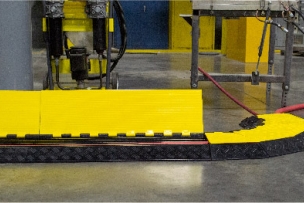The Environmental Protection Agency’s (EPA) Spill Prevention Control and Countermeasures (SPCC) Rule aims to prevent illegal discharges of oil into navigable U.S. waters and adjoining shorelines. The EPA acknowledges that primary containers can fail and requires companies that store high amounts of oil to have secondary containment.
The SPCC rule requires facility owners or operators with more than 1,320 gallons of above-ground oil storage capacity or 42,000 gallons of underground oil storage capacity to have a written plan that addresses how the facility will prevent oil spills to navigable waters and adjoining shorelines. Regulations also require facilities to be prepared for, and have the ability to respond to oil discharges, if the processes and/or devices put into place fail.
Violations of SPCC secondary containment requirements have historically resulted in companies being fined thousands of dollars.
The EPA does not specify particular methods or devices that must be used or applied to prevent discharges, which gives facility managers the flexibility to determine the best way for their facility to comply.
The methods listed in a facility’s plan should be in accordance with accepted “good engineering practices,” and sometimes must be certified by a Professional Engineer (PE).
Secondary Containment
Secondary containment for bulk containers is a required element of SPCC. The EPA’s SPCC Guidance for Regional Inspectors states that “secondary containment is required for all facilities with bulk storage containers, large or small, manned or unmanned, and for facilities with bulk storage containers that also have oil-filled equipment.”
According to the EPA, a bulk container is “any container (with a capacity of 55 gallons or more) storing oil at a facility. Bulk oil storage containers may include, but are not limited to tanks, containers, drums and mobile or portable totes.”
Oil-filled equipment — such as transformers, hydraulic systems, lubricating systems, gear boxes, machining coolant systems, heat transfer systems, circuit breakers and electrical switches — must also have secondary containment.
Active Versus Passive
According to the EPA, secondary containment can be active or passive as long as discharge cannot escape the device [40 CFR 112.7(c)].
Active secondary containment is when an employee personally contains a spill. Active secondary containment includes:
- Deploying drain covers before a spill happens
- Deploying drain covers after a spill has occurred, but before the spill reaches a drain
- Using a spill kit in the event of an oil discharge
- Having a spill response team in the event of an oil discharge
- Closing a gate valve prior to a discharge
Active secondary containment may not be appropriate or possible for all situations due to lack of resources and staff. Unlike active secondary containment, passive secondary containment does not require deployment or the action of an employee or employees to contain a spill.
Passive secondary containment includes:
- Placing containment pallets or decks under drums and other containers
- Surrounding machines and containers with berms
- Erecting retaining walls around machines and containers
- Placing drip trays under leaky machines and containers
General and Specific Containment
The EPA specifies two types of secondary containment requirements under the SPCC rule: general and specific.
The general secondary containment requirements are “intended to address the most likely oil discharge from bulk storage containers; mobile/portable containers; production tank battery treatment, and separation installations; a particular piece of oil-filled operational or process equipment; (non-rack) transfer activity; or piping in accordance with good engineering practice,” according to the EPA’s SPCC Guidance for Regional Inspectors.
There is no specified volume that needs to be contained under the general requirements because they address the “most likely oil discharge” and encompass containers, processes and oil-filled equipment.
According to the EPA’s SPCC Guidance for Regional Inspectors, the specific secondary containment requirements are “intended to address a major container failure… these specific provisions explicitly provide requirements for sizing, design and freeboard that need to be addressed in the SPCC Plan.”
Specific secondary containment requirements apply to the following:
- Bulk storage containers
- Loading/unloading racks
- Mobile or portable bulk storage containers
- Production facility bulk storage containers, including tank batteries, separation, and treating vessels/equipment
Unfortunately, the SPCC rule does not specifically define the term “freeboard,” nor does it describe how to calculate the volume for secondary containment. A PE can help determine if a containment system has sufficient volume. Two generally accepted methods for determining sufficient freeboard for a containment device include:
- Using historical data from the past 25 years to calculate the volume based on the worst 24-hour storm event in the area
- Ensuring that the sump is capable of holding 110% of the volume stored
Containment Considerations
Facility managers should consider the following points to determine what type or types of secondary containment are appropriate for their various areas and/or processes:
- What are the potential sources of failure that may cause a discharge?
- How quickly can oil be discharged?
- How will discharges be detected?
- How will personnel react to a discharge?
Whether containment is active or passive or general or specific, the goal is always the same: preventing oil from being discharged into navigable waters or adjoining shorelines. Having the ability to contain spills at or near their source helps minimize the potential for discharge.
Previously Featured on New PIG's blog.





Talk to Us!
Leave a reply
Your email address will not be published. Required fields are marked *